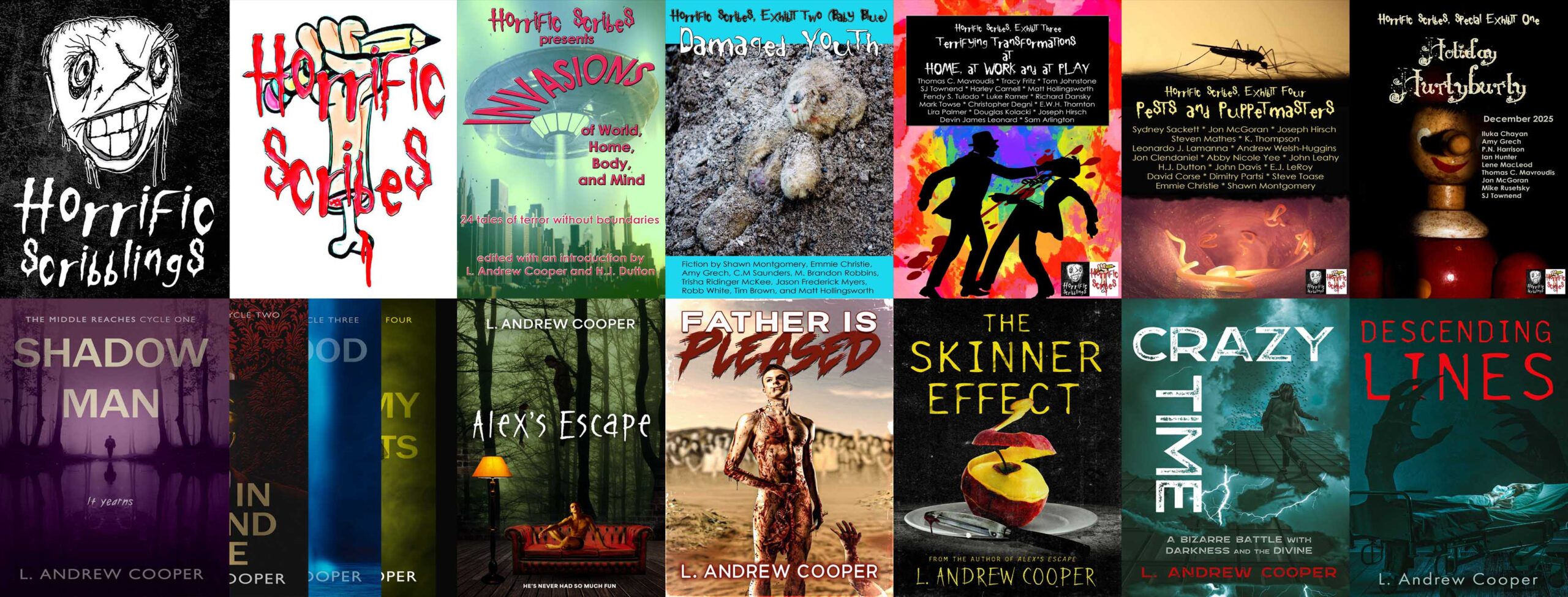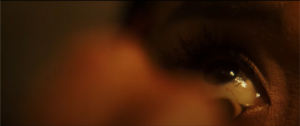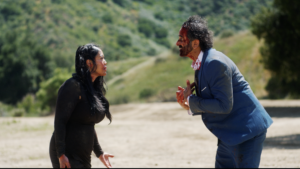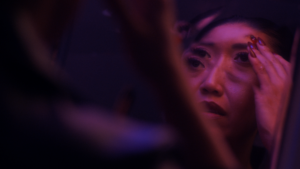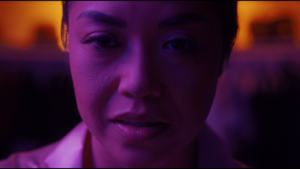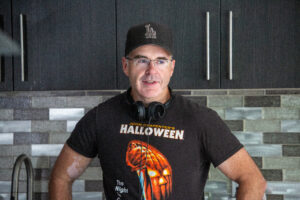Interview with Filmmaker Justin Best: Sheryl (2024)
Fantasy, adventure, comedy, even YA–filmmaker Justin Best applies his considerable talents in many areas, but we’re talking about his edgy horror feature Sheryl, which took home the award for Best Thriller Feature at this year’s Miami International Science Fiction Film Festival.
Sheryl
After she’s dumped by her serial killer boyfriend for not being “hot enough,” Sheryl, a beauty-obsessed woman, goes on a murderous, blood-soaked quest to create the perfect face while simultaneously navigating her new relationship with the cop investigating the murders. In the end, she must try to learn to accept herself as she is… even if that means she is a looks-obsessed psycho-killer.
The Interview
1. Opening Eye. Sheryl’s opening shot is an extreme closeup of an eye, which seems appropriate for a film deeply concerned with appearances. It also seems to tap into a long tradition in horror movies of focusing on eyes, particularly killers’ eyes but also victims’, when dealing with matters of perspective and the vulnerability of viewers. What does the opening eye of Sheryl convey? Sheryl’s eye is having eyeliner applied—why throw in makeup as part of this initial impression? In what ways is and isn’t Sheryl’s eye a traditional horror movie eye?
JMB: First of all, thank you thank you for taking the time to watch Sheryl and for this great question. Yes, there does seem to be a great tradition of eyes in horror movies, whether it’s looking through the eyes of the victims/killers or grotesque enucleation or other damage to the eyes. For me, I think this plays into the idea that the eyes are both very physically sensitive and emotionally expressive.
I believe opening scenes are very important in movies and the opening eye scene of Sheryl was created with the goal of conveying a few things – (1) It was meant to create an uncomfortable feeling from the beginning and to let the audience know that we are watching a horror movie and (2) to your point, letting the audience know that this is perhaps not your traditional horror movie. There’s nothing especially sinister going on in the opening scene; the act of applying eyeliner is something that many people do every day. Yet, the idea of jamming a sharp object so close to such a sensitive part of your body is something that is very uncomfortable to me.
Additionally, the opening eye is followed up by the hair, the lips, the nails, etc. Again, my thought process here was twofold: (1) We see Sheryl in pieces, not as a complete woman, which I think is sometimes how women are viewed – not as actual people but as legs, eyes, lips, and so on. This is also how Sheryl herself views other women. And (2) here is a woman who is willing to inflict a type of violence upon herself – pointing a sharp stick towards her eye, burning her hair, wearing uncomfortable shoes, etc. – in her pursuit of external beauty. What might she do to someone else? By incorporating this makeup ritual, I hope that we can make the audience uncomfortable, while at the same time create a connection between the audience and Sheryl by showing her doing things that, if we zoom in (in both the literal and metaphorical sense), might be unusual, but in their usual context, they are normal to a lot of people.
2. Killer Standards. Sheryl’s serial killer boyfriend, Ted, tells her she isn’t “hot enough” and treats her abusively, sending her into a spiral in which she kills in a quest for greater beauty. Do Ted’s standards, the standards of a sadistic killer, reflect on the standards for beauty that men impose on women? Why or why not? Why don’t questions about Ted’s hotness enter the conversation? To what extent is Sheryl’s beauty obsession an internalization of patriarchal expectations?
JMB: Ted is, to use Sheryl’s words, “just an asshole,” but perhaps one of the worst kinds of assholes in that he is, to everyone other than Sheryl, quite a catch. He’s well-off; he’s handsome; he doesn’t swear; we never see him be physically abusive with Sheryl. He’s also incredibly charming, and I think it’s this last part that makes him relatable to a lot of women (And shoutout to Shaan Sharma for bringing Ted to life in such a way that people hate Ted, but also see the attraction to him). He’s extremely emotionally and verbally abusive towards Sheryl, but he has a way of making her think that it’s her fault, and, in that way, she’s sort of battling herself in regard to whether or not she’s going to trust herself or trust him.
I do think that his standards for beauty and the way he treats Sheryl are something that a lot of women seem to be able to relate to. In talking with the women in my life, and just trying to be aware of what’s happening in the zeitgeist, it appears that women, regardless of what they may accomplish, are still judged largely by their appearance, and there are certainly a number of men out there who have no concern for their own appearance, while at the same time, they expect women to look their-version-of-perfect at all times.
As you mentioned, Ted’s hotness is never even considered, and that’s because he knows that he’s not going to be judged in the same way that he and everyone else in the film judge Sheryl. In my own life, I will throw on a hat and a t-shirt and be ready to go, while my wife might change outfits several times and spend a significant amount of time doing her hair and makeup. This is because she knows that other people will be judging her in a way similar to how Ted judges Sheryl.
I’m not an expert by any means, but I think patriarchal expectations are so ingrained in our society that it’s very difficult to see that they are even there or where they might begin and end. I do think that Sheryl has internalized a lot of patriarchal/societal/cultural expectations, as have a lot of people. It’s how she reacts to these thoughts and expectations that make her a killer.
I did not write Sheryl with the intent of saying that one should or shouldn’t care about their appearance. Overall, I want to say do what makes you happy (as long you’re not actually a serial killer. Don’t do that.), but I do think it’s also important to think about why we do the things we do.
3. Killer Sympathy. The film tells Sheryl’s story from her point of view, exploring her emotions and motives in ways that make them at least somewhat understandable. She’s a killer, but… do you think viewers will find her sympathetic? Why or why not? She presents herself as an average woman tired of being shit on, tired of people not seeking to know her true self, tired of not being free. Do you think her frustrations with the world, which are a little off kilter considering her murder habit, are part of her psychopathy, or do they make her a kind of everywoman? Why?
JMB: Definitely we spent a lot of time discussing how we can create sympathy/empathy for Sheryl. We really wanted viewers to think just that – She’s a killer, but… Overall, it seems that we have been pretty successful in that as many fans have expressed to me that she’s more of an anti-hero than a traditional horror slasher. I hope that people will leave the theatre and have a conversation about Sheryl and why she does what she does.
I think that one major way that we create this empathy for her is by putting her in normal situations (such as going on a date, talking to her friend, interacting with her boss), and then we make the people that she interacts with horrible people. I think it’s these common interactions and frustrations that make her very relatable, and that’s a credit really to the performance by Anthea Neri-Best. There was a version of Sheryl that we called “Sterile Sheryl” where Sheryl was very cold and obsessed with everything in her life being perfect, such as having perfectly organized rows of makeup. Not only was this very challenging from a production standpoint, but it put a wall between Sheryl and the audience. Playing her as an everywoman helped the audience to really connect more with Sheryl, which was our goal.
So I think her frustrations are regular frustrations that many people can relate to, and part of the fun of the movie is that Sheryl is able to live out this revenge fantasy for us. We know that we can’t – and shouldn’t – murder the jerks in our world, but Sheryl is able to do this for us, and that catharsis is part of the appeal of the film.
4. Killer Comedy. Though it has serious themes, Sheryl is often quite funny, especially when depicting the dynamic between Sheryl and Ted and in murder sequences from killers’ perspectives that give the grotesque dimensions of the casual and the absurd. “Comedy” is even one of Sheryl’s categories on IMDb. Why add laughs (or at least wicked smiles) to the film’s mix? How does the comedy combine with horror, and how do you expect the combination to affect audiences? If the film contains an element of satire, what are you satirizing?
JMB: I love comedy and laughing, so anything that I write is most likely going to have some element of comedy in it. For me, movies have always been a way to escape the horrors and drama of real life, so when I watch a movie, I like to have fun, and to me, fun means laughter.
To me, comedy and horror are very closely related. They both are very visceral, and they both rely on timing and an element of the unexpected to achieve their affect. To me, Sheryl is very funny at the beginning of the film and, while the comedy never goes away, it lessens as the film goes on. My hope is that the comedy will hook the audience so that they want to go on this wild ride with us. It also helps to relieve the tension on what might otherwise be a really heavy film. In this way, the darker or more serious moments hit even harder when juxtaposed against the funnier moments. When we see Ted get serious, we can see actually how evil he is. When we see Sheryl get serious, we see how much things have affected her. I believe this all contributes to helping us tell the best story we can.
5. Killer Romance. Sheryl could just be a collection of gory set-pieces, but instead it devotes a considerable amount of screen time to character development, a lot of that time to developing the relationship between Sheryl and her new cop boyfriend, David. What does this romance storyline add to the film both as a viewing experience and as the story of a woman trying to cope (homicidally) with the pressure to be beautiful? How does the romance combine with the horror and comedy?
JMB: This is another way that we create empathy for Sheryl. The whole reason that Sheryl does what she does is because, at the end of the day, she really just wants to be loved for who she is. I think that’s what we all want. In the film, Sheryl has a few chances to choose between David and her victims, and she makes her choice. So many people chase beauty or wealth or status because they think that it will earn them love from other people, but it doesn’t. It might temporarily, but I believe that what so many of us are searching for is that inner self love that doesn’t depend on external circumstances. In her own way, Sheryl finds this, or at least thinks she does.
I think the romance is another primal emotion that matches well with the comedy and the horror. Plus, it adds another fun layer to the mix. David and Sheryl are essentially lying to each other, and we know they’re going to find out the truth. We just want to know what’s gonna happen when they find out.
6. Killer Style. The film’s stylization helps the genre blend to feel more natural. A contemporary, well-mixed soundtrack carries the mood, and the camera’s presence announces itself, creating an aura of self-reflexivity, as when labels appear to name characters in the beginning, text messages appear not on shots of phones but on the screen itself, and lots of splatter dirties the lens. I’ve named a few details that stood out to me—what would you say defines the style of the film and perhaps your style as a director more generally? What are your favorite techniques for crafting the experiences of your audience? Do you think of your style as self-reflexive? Why or why not?
JMB: Thank you for saying this. I don’t really think of myself as self-reflexive, but I could see why that might come up. For me, I generally thought about what I would like to see on the screen. What would make this fun to me? And what would help to tell the best story?
My background is music, so sound and audio are very important to me. I felt very fortunate to find a great group of songs that fit the film for the soundtrack, and a great sound engineer in Chris Woll at Downmix Studios who made it boom! We really worked to mix the movie almost like an album. I wanted the audience to feel it as much as possible.
You really hit the nail on the head – For me, I want to create an experience. When you watch a Justin Best film, I want you to see it, hear it, feel it, smell it. I want to bring people in so that they can forget about life for a while and just enjoy what they’re seeing on the screen. Our time is the most valuable resource, so I want to honor the audience’s choice to give me their time with the best movie I can give back.
For me, things like the labels on the screen are both fun and purposeful. As you said, it adds some stylization but also helps people get the lay of the land very quickly. The dialogue moves fast by design, so I really wanted to help people understand who is who and how they’re related. Same with things like the blood splatter – we couldn’t always do the blood practically, so adding some on the screen gave me the feeling I wanted while also helping to bring the audience into the experience.
Everything in Sheryl was done for a reason. We really wanted to use everything in the film to help tell the story. One area where this is most representative is in the wardrobe, and again, this is a testament to the work that our costume designer, Stephanie Nguyen, put in. At the beginning, Sheryl is wearing dark, constrictive dresses with a huge purse, but as time goes on her outfits change until, at the end, she’s wearing an all-white pants outfit.
Overall, Sheryl is pretty representative of what you’re going to get from a Justin Best film. From the killer music to the quippy dialogue to the heart, this is the kind of film that I am excited to make more of in the future. We like to say that it’s the most fun you can have with your clothes on.
7. Franken-face, Leatherface, et al. Since one of Sheryl’s primary goals in the film is to sew together a “perfect face” from perfect parts, a face she can wear, people make offhand comments about her creating a “Franken-face” and her trying to be a “female Leatherface” (she does use a chainsaw at one point). I’m pretty sure I caught a reference to Buffalo Bill, too. Though these references aren’t at all belabored in the film, they still strike me. To what extent do you see Sheryl engaging with the styles and/or themes of Frankenstein, Texas Chain Saw Massacre, Silence of the Lambs, and perhaps other precursors? I’m on tradition again—where do you see Sheryl taking this tradition of stitching and skin?
JMB: I’d be very happy to see Sheryl mentioned in the same breath with those classic stories! I never thought consciously of any of these stories when I was writing Sheryl, but I believe they influenced me on some level. Frankenstein depicts a creature seeking companionship before turning to revenge. Silence of the Lambs depicts a woman overlooked in her profession who has to deal with a charming psychopath. Texas Chainsaw depicts a person wearing someone’s else face and wielding a chainsaw. These stories are a part of our modern mythology now.
I hope that Sheryl helps to build on this mythology and push it forward. My goal with Sheryl was to take these commons stories and tropes and tell them in a new way. Of course, when we were making the film, we never thought about any of this – we just wanted to make a badass movie.
So, if people just want to watch a badass woman hack up bad people, they can do that and have a great time. Also, I think it’d be great if someone watched this film, and it inspired them to make their own addition to the skin-stitching pantheon.
8. True Knowing, True Beauty. Sheryl is concerned about people not truly knowing her and about finding her true self; Ted is over-confident about truly knowing Sheryl; David truly wants to know Sheryl, or at least thinks he does. Although Sheryl is cautioned not to seek perfection and about being too obsessed with appearance, she wants the perfect face, true beauty. How might the movie answer these questions: can a person ever really know another person? Can a person ever really know themselves? Is perfection possible? Does true beauty actually exist?
JMB: These are some deep questions! And are exactly the kind that I’m excited for audiences to discuss after seeing the film. I personally believe that what a lot of us humans are searching for is connection – both with ourselves and with each other. Part of the beauty of life is making progress towards that connection.
There are a lot of things vying for your attention today, and a lot of these things, whether consciously or unconsciously, are working to separate you from yourself. To me, that’s basically what marketing is: You’re not good enough. Buy our stuff and you will be good enough. Sheryl is cautioned not to seek perfection, and she ignores this warning, but she’s hardly the first. Countless individuals, both in real life and in fiction, have chased wealth, fame, beauty and more, much to their detriment.
Sheryl says to one of her victims that when she is with her that “there’s a connection.” Sheryl seems to think that killing is the only way that people notice her – the only way that she can connect with herself and others. Obviously, this is a movie and an extreme example, but many people do seek love and connection in unhealthy ways.
I believe that when you’re able to see past all of the distractions of the world, and discover who you are at your core, this leads to fulfillment. From there, I believe that you’re more likely to go out and find people that you truly connect with on a deeper level, whether that’s friendship or a romantic relationship.
I’ve been with my wife for 13 years, and we’re still learning new things about each other, and we’re both learning things about ourselves. So, I don’t know if it’s possible to completely ever know another person or yourself, but that growth is, to me, the purpose and joy of life.
Today, it does seem like perfection and true beauty are more attainable. We can photoshop or facetune a picture to death. In a music studio, you can autotune every note until it’s perfect. On set, we could shoot over and over until we got it “perfect” because we weren’t limited by film. But, often, when we listen to these “perfect” songs or look at a “perfect” picture, we can sense that it’s off. It’s lost its soul.
As Sheryl says in the film, there’s always someone prettier. When you’re seeking external validation, there’s always going to be someone who’s better/richer/prettier/whatever-er. So, I don’t know that perfection or true beauty exists in the way that it’s usually marketed to us.
On the other hand, we live on a rock spinning through the galaxy at just the right speed and just the right distance, and our parents had to meet and their parents had to meet and so on – all these conditions had to be perfect for us to even be here. At the same time, we’re surrounded by trees and mountains and oceans and amazing structures. We get to witness the smile of children or the joy of accomplishing a goal or the connection of looking in a loved one’s eyes. To me, that’s pretty beautiful.
9. Access! How can readers learn more about you and your works (please provide any links you want to share)?
JMB: We are on all the social media platforms at @SherylTheMovie, but the best place to keep up with all things Sheryl is on Instagram at www.instagram.com/sherylthemovie. We’re currently making our festival run, and we have a comic book version of Sheryl coming soon, so follow us on IG and the other social media sites to find out when we’ll be coming to a city near you. Readers can also learn more about Sheryl, the cast and crew, and more at www.sherylthemovie.com. Also, if you’ve seen the film be sure to leave us a review on letterboxd and IMDB, as those things really help a grassroots, indie film like Sheryl.
Also, I want to say thanks again to you, Andrew, and your readers for supporting the indie horror arts. Time is the most valuable thing we have, and for ya’ll to take the time to watch our film and want to learn more about it, it means a lot to myself and the whole Sheryl team. We worked hard to create the best film we could make, and we want people to see it. Liking, subscribing, going to a festival, interacting on social media – it may sound trite, but it really means a lot, so thank you again for your time and your support! I look forward to making more creepy things and sharing them with you in the future!
SHERYL: LINKS
Website and Social Media
WEBSITE: www.sherylthemovie.com
INSTAGRAM: www.instagram.com/SherylTheMovie
FACEBOOK: www.facebook.com/sherylthemovie
TWITTER: www.twitter.com/sherylthemovie
TIK TOK: www.tiktok.com/@sherylthemovie
IMDB: www.imdb.com/title/tt13117642
LETTERBOXD: https://letterboxd.com/film/sheryl-2023/
Watch the Trailer!
www.youtube.com/watch?v=wLIN6FI0Sh4
JUSTIN BEST LINKS
Website: www.justinbest.rocks
Instagram: www.instagram.com/jmichaelbest
Twitter: www.twitter.com/jmichaelbest
About the Filmmaker
Justin Best is a writer and director who studied feature film writing at UCLA Extension under Michael Weiss (Journey to the Center of the Earth) and improv comedy and sketch writing at Upright Citizen’s Brigade. His debut feature film, SHERYL, recently won the Jury Award at the Crimson Screen Film Festival, and won Best Horror Feature at the International Horror & Sci-Fi Festival/Phoenix Film Festival and the Miami Sci-Fi Film Festival. SHERYL was also nominated for 11 awards at the Spring HorrorHound Festival. His script for SHERYL was a quarterfinalist in the Academy Nicholl Fellowship in Screenwriting, and he was also the writer for The Living Remain, a virtual reality horror video game called the “best VR campaign since Resident Evil 4.” Justin is also the founder of BxB Studios, a multimedia production studio designed to create fun, empowering stories with heart.
